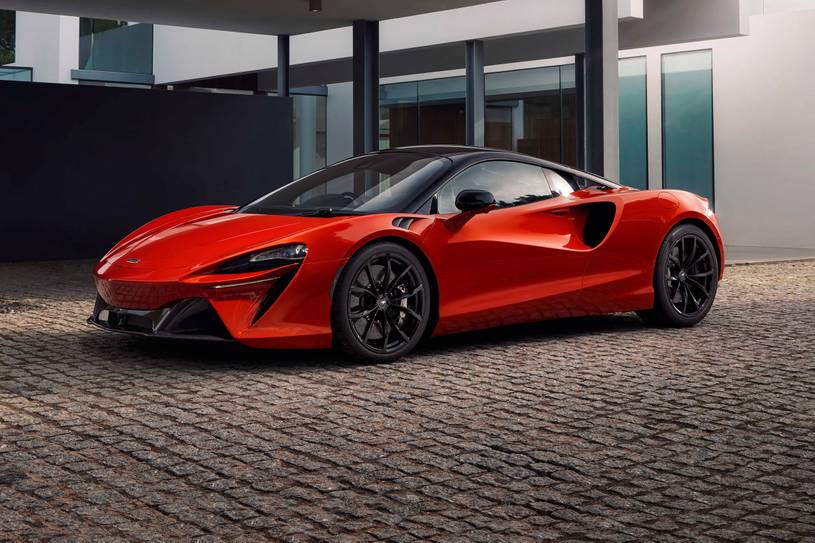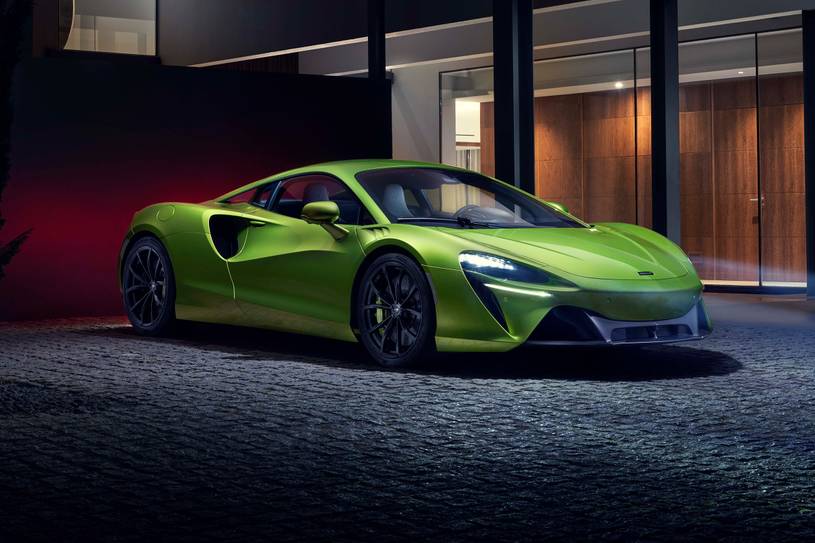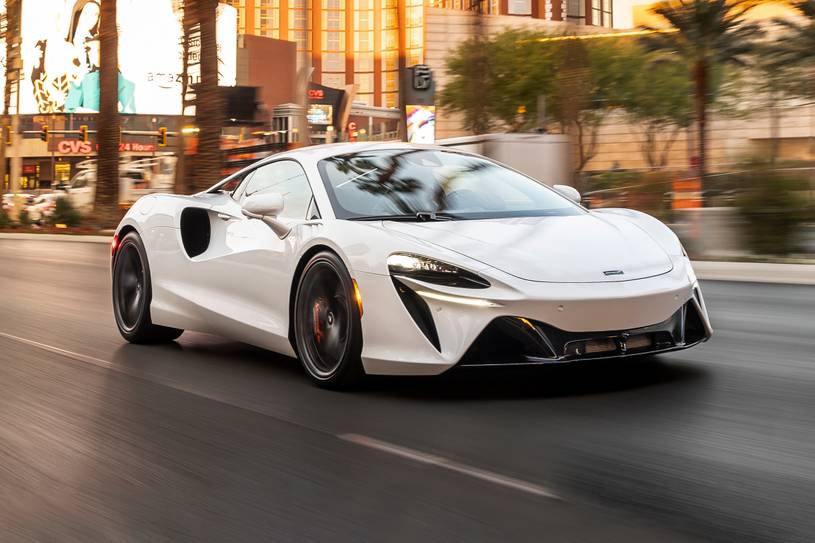When the car turns on, it defaults to all-electric mode (given there's charge in the battery), but a drive mode rocker switch mounted within a finger's reach of the steering wheel can fire that engine up with just a simple click. There are four modes: E-mode, Comfort, Sport and Track. Comfort mode acts like a traditional hybrid, using electricity at low speeds or while at stoplights and firing the engine up when you demand it. Rather than using the electric motor to improve efficiency, Sport and Track modes use it to improve performance, expending more energy at lower speeds to improve torque and throttle response.
The suspension has three basic settings tied to each drive mode, but it's adaptive and constantly adjusting on the fly. McLaren is using a new rear suspension design that it says improves stability and reduces understeer. The stability and traction control are adjustable, too. Traction control uses what McLaren is calling Variable Drift Control. Rather than on and off, traction control can be backed off incrementally to allow for some rear-out antics if you're so inclined. Aiding traction is the Artura's electronic locking differential. Using an e-diff saves weight versus a mechanical differential and allows for precise control over how much torque is being sent to each rear wheel.
Given everything McLaren has thrown at it, it's no surprise that the Artura is an obscenely fast machine that can quickly send you well past the speed limit with a dip of your right foot. Power response is immediate and fierce, provided you don't have it in all-electric mode. The battery allows for an EPA-estimated all-electric range of 11 miles, though power is limited to what the electric motor can provide. It's enough for city driving, and while you can drive up to 81 mph with electricity alone, it will take a bit to get up to that speed as power falls off dramatically past 30 mph.
There's more than enough power on tap for any public road. We had a chance to drive the car both on the street and on a short 1.4-mile road course, though that course included a straight long enough to find that fourth gear will take you to at least 131 mph. The Artura's top speed is an electronically limited 205 mph.
The engine revs quickly, and redline is a heady 8,200 rpm. If you shift by ear rather than eyeballing the tach or leaving it in automatic, there's an inclination to short shift. As with other screamers like the Ford Shelby GT350's V8, the Porsche 911 GT3's flat-six and the Honda S2000's inline-four, it takes a minute to get used to having a higher rev ceiling. The difference here is that those three were all naturally aspirated engines, whereas the Artura of course is a turbocharged hybrid. High-revving engines can feel a bit weak at low revs, but that's where the electric motor and turbochargers benefit the McLaren. It helps offer smooth power delivery rather than the swell that can come with powerful turbocharged cars.
Because there's an extra gear in the transmission, the gear ratios have been tightened up in an effort to further improve throttle response. The dual-clutch transmission is very responsive, and the one-piece wheel-mounted shift paddle is satisfying to use. But at low speeds, especially when coming to a stop, downshifts can feel clunky and a bit unrefined.
Speed is far from everything. Handling is paramount in sports cars, and the Artura mostly delivers. The car feels planted and stable on the street, tackling a winding back road with aplomb. The steering is still hydraulically assisted and offers excellent feedback. It's quick and weighted well, with enough heft to give you a sense of what the front tires are doing without feeling overly heavy. That's good, as there's only one setting for the steering. McLaren says it wants the steering to feel consistent no matter the drive mode. We think that's a good thing because electronically assisted power steering all too often feels compromised and numb.
Part of the beauty of moving the engine is freeing up weight over the front axle and pushing the cabin forward. It makes the Artura quick to turn in, though on the road course we did notice the nose pushing a bit on tighter corners. If you back off the traction control a few notches, you can use the throttle and e-diff to mitigate understeer and rotate the rear.
In addition to improved handling in corners, the Artura's e-diff helps with high-speed stability, too, say like cruising on the highway or barreling down the straight on a track. The Artura has a relatively short wheelbase to help make it feel nimble in corners. Longer wheelbases provide more stability at speed, but the way the differential can adjust torque on the fly can be used to help provide the same stability with a shorter wheelbase.
The Artura wears big carbon-ceramic rotors with six-piston front and four-piston rear calipers. McLarens all tend to have firm brake pedals, and the Artura is no different. As with the steering, McLaren wanted the brake feel to be consistent all of the time, so, somewhat unusually for a hybrid, the Artura does not use a brake-by-wire system, and as such, there's no regenerative braking at all. The upshot is that the brakes always feel the same no matter what drive mode you're in. The pedal is firm, but it feels strong and is easy to modulate. We didn't notice any fade during our day behind the wheel.
McLaren worked with Pirelli on a new tire for the Artura. It comes standard with Pirelli P Zero summer tires, while higher-performance P Zero Corsa tires are available. All of the test cars were fitted with the latter. They're staggered, sized 235/35ZR19 front and 295/35ZR20 rear. But these aren't the typical P Zeros you can order off of Tire Rack. The compound was developed for this car and, interestingly, features a Bluetooth chip embedded inside the tire that communicates with the car. The car can automatically recognize the compound as well as read tire pressures and temperatures.








